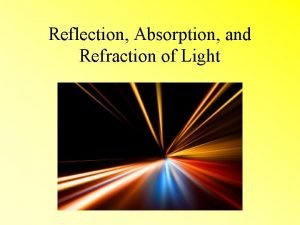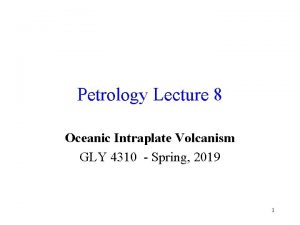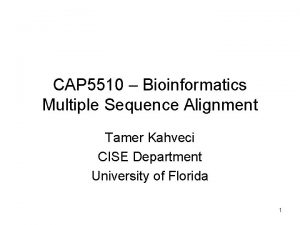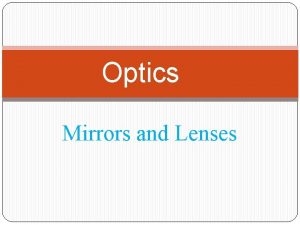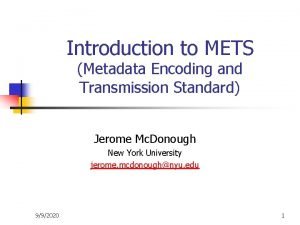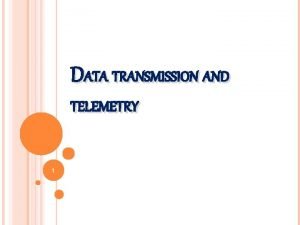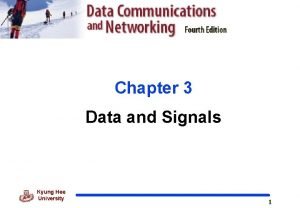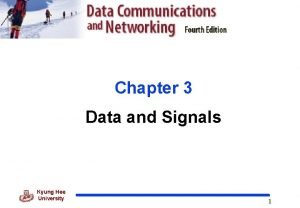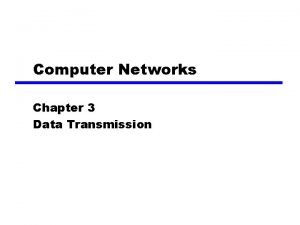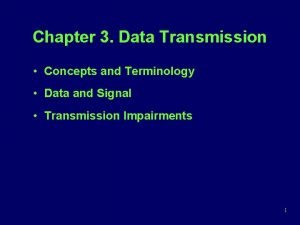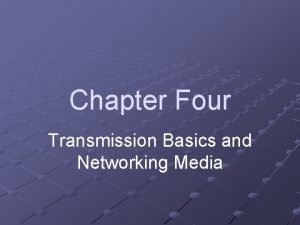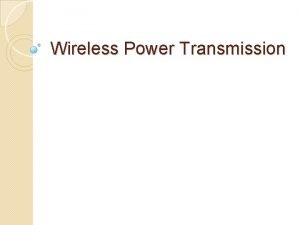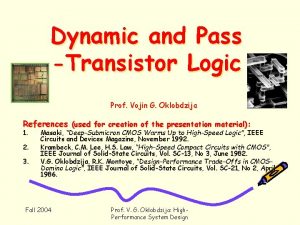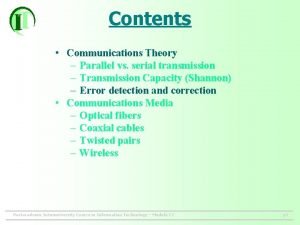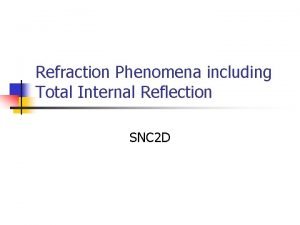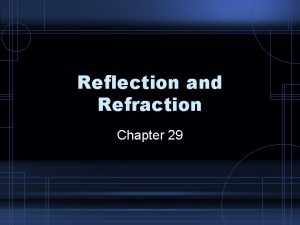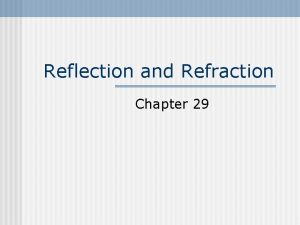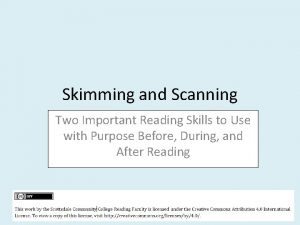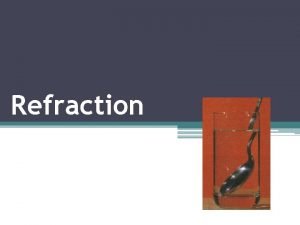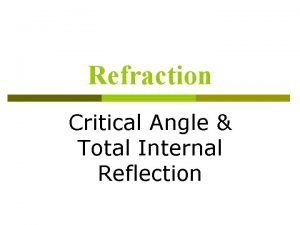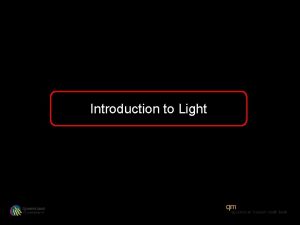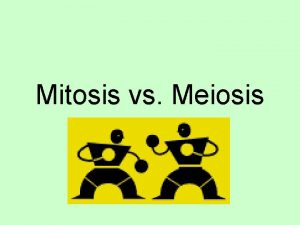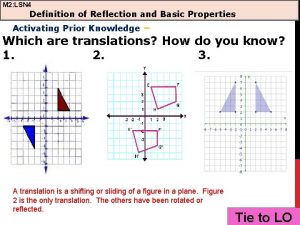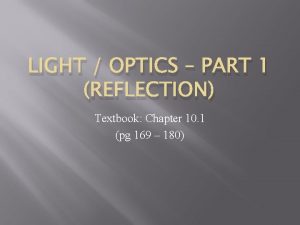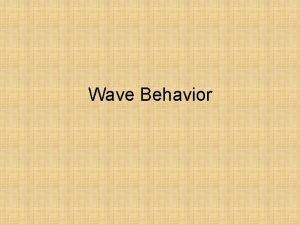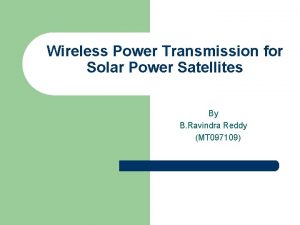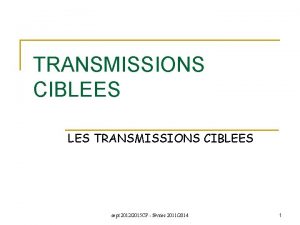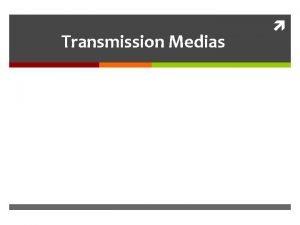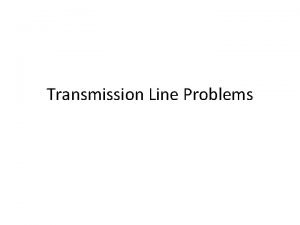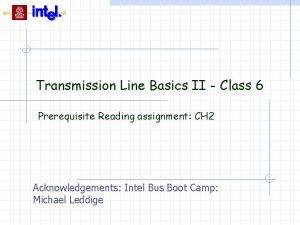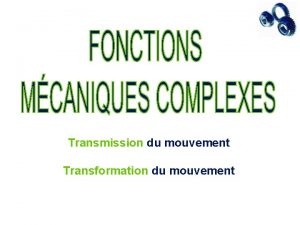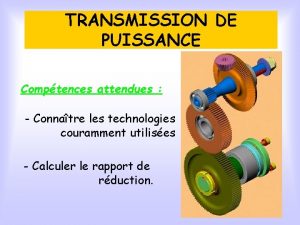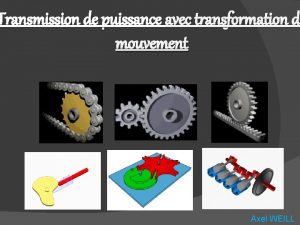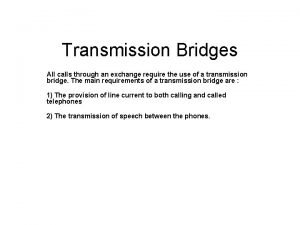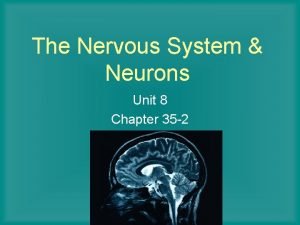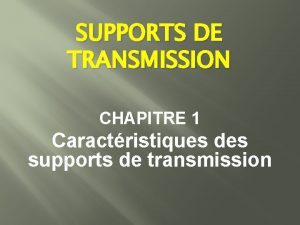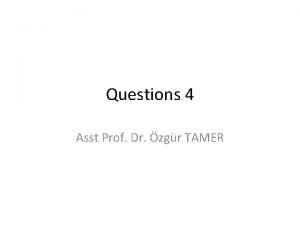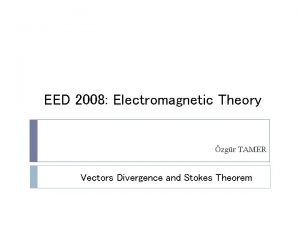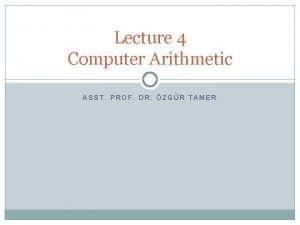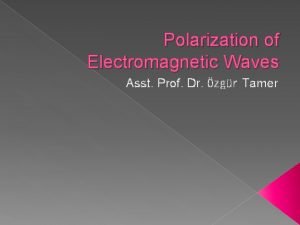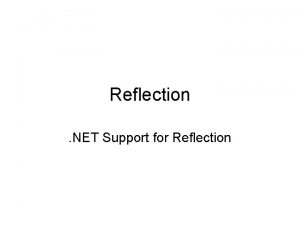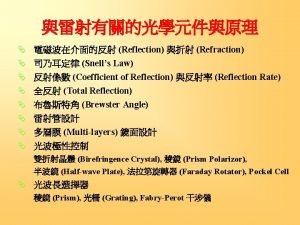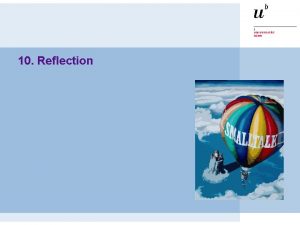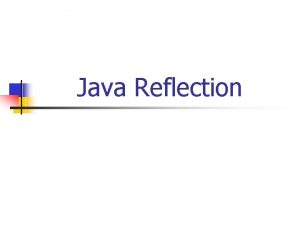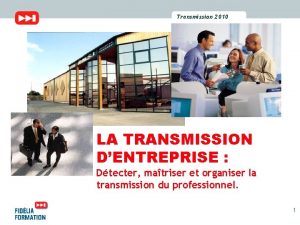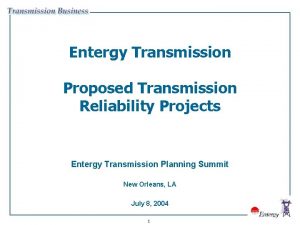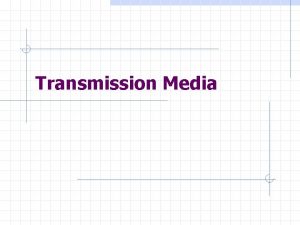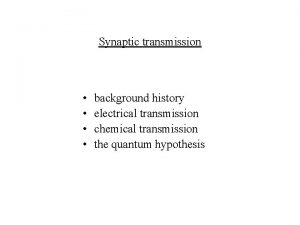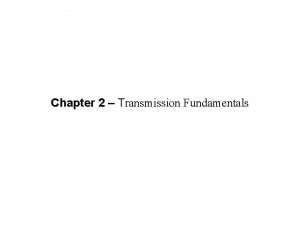Reflection and Transmission Asst Prof Dr zgr Tamer























































































- Slides: 87

Reflection and Transmission Asst. Prof. Dr. Özgür Tamer

Normal Incidence

Normal Incidence Incident wave Reflected Wave

Normal Incidence Transmitted wave

Normal Incidence At z=0 the combined fields on the left (incident and reflected)must join the fields on the right (transmitted) according to the boundary conditions For the normal incidence all components are parallel, so;

Normal Incidence For the magnetic field

Normal Incidence Reflected and Transmitted waves can be found as

Normal Incidence If the permeabilities are close to μ 0, then;

Normal Incidence The reflected wave is in phase if u 2>u 1 or out of phase otherwise The real amplitudes are given by;

Normal Incidence Energy: The Intensity (average power per unit area) is given by

Normal Incidence The ratio of the reflected intensity to the incident intensity is given by; And for the transmitted energy

Normal Incidence Г is called the reflection coefficient and T is called the transmission coefficient

Standing Wave Ratio The total electric field becomes For any media we can define a phase angle and a reflection coefficient

Standing Wave Ratio If the incident wave is given by And the reflected wave is The total field becomes

Standing Wave Ratio Since The total wave does not contain the factor it is a standing wave instead of a travelling wave. Etot(Z, t)=EI(Z, t)+ER(Z, t) There are planes in which Etot(Z, t) is minimum and maximum at all times

Standing Wave Ratio The instantaneous values of the two vectors are

Standing Wave Ratio

Standing Wave Ratio It increases with the increase of the magnitude of the reflection coefficient·

Oblique Incidence Oblique incidence is a more general term covering also Normal Incidence

Oblique Incidence Again we have an incident wave and the reflected wave becomes

Oblique Incidence While the transmitted wave is

Oblique Incidence The three wavenumbers are related by › Since Reflected and Incident angles are in the same medium

Oblique Incidence The combined fields in medium 1 Must be joined with the fields in medium 2 Boundary conditions must be satisfied all points on the plane

Oblique Incidence x, y and t dependence can be observed from the exponential parts t is already equal for all media And for the spatial terms

Oblique Incidence More explicitly

Oblique Incidence Lets be more specific and For this case kı lies in the x z plane as well as k. R and k. T Concluding: › The incident, reflected and transmitted wave vectors form a plane which also includes the normal to the surface

Oblique Incidence where θI is the angle of incidence, θR is the angle of reflection, and θT is the angle of transmission (more commonly known as the angle of refraction) all of them measured with respect to the normal

Oblique Incidence Law of reflection: The angle of incidence is equal to the angle of reflection › θ I = θ R. law of refraction—Snell’s law

Oblique Incidence Since we got rid of the exponential parts the boundary conditions become

Oblique Incidence If the polarization of the incident wave is parallel to the plane of incidence, reflected and transmitted waves are also polarized in the same plane Then we have using the first boundary condition

Oblique Incidence Since the magnetic fields have no z components the third boundary condition becomes The fourth equation

Oblique Incidence

Oblique Incidence These are known as Fresnel’s equations, for the case of polarization in the plane of incidence. › the transmitted wave is always in phase with the incident one › the reflected wave is either in phase if α > β, or 180◦ out of phase if α < β

Oblique Incidence The amplitudes of the transmitted and reflected waves depend on the angle of incidence, because α is a function of θI › In the case of normal incidence (θI=0), α=1 › At grazing incidence (θI= 90◦), α diverges, and the wave is totally reflected

Oblique Incidence Brewster’s Angle › at which the reflected wave is completely extinguished › this occurs when

Oblique Incidence For a typical case practical formulas

Oblique Incidence › light incident on glass (n 2=1. 5) from air (n 1=1)

Oblique Incidence The incident intensity is while the reflected and transmitted intensities are

Oblique Incidence The reflection and transmission coefficients for waves polarized parallel to the plane of incidence are

Oblique Incidence The reflection and transmission graphs vs angle of incidence (R=1+T)

Reflection at a Conducting Surface In case of free charges and currents the boundary conditions become Where is the free surface charge Kf is the free surface current and n is the normal vector

Reflection at a Conducting Surface For ohmic conductors there can be no free surface current since J is a volume current density which is a current per unit area perpendicular to the flow direction A surface current density is amps per unit length perpendicular to the flow. This 'length' is just a 1 -D line. . . it has no area. We set K=0 in the boundary conditions

Reflection at a Conducting Surface Suppose xy plane is a boundary between a dielectric and a conductor The incident wave is given by

Reflection at a Conducting Surface The incident wave gives rise to a reflected and a transmitted wave The transmitted wave is attenuated as it penetrates into the conductor

Reflection at a Conducting Surface Since on both sides, boundary condition yields Since Kf is zero

Reflection at a Conducting Surface And similarly we have For a perfect conductor The wave is totally reflected with a 180 degrees phase shift

Problem 1 Find the reflection and transmission coefficients for the interface between air and fresh water (E = 81ε 0, σ = 0), in the case of perpendicular incidence.

Problem 2 A plane wave is normally incident on the interface between air and a dielectric having a permeability μ= μo, and an unknown permittivity. The measured standing-wave ratio in air is 1. 8. Determine ε.

Problem 3 A plane wave with parallel polarization is incident at an angle of π/4 from air on a perfect dielectric with εr = 4 and μ = μo. Find the Fresnel coefficients. What fraction of the incident power is reflected, and what is transmitted into the dielectric?

Reflection at a Conducting Surface Oblique Incidence › For lossy media Snell's law of refraction can be written as › For an dielectric and a lossy conductor interface we have

Reflection at a Conducting Surface By using a trigonometric identity The wave transmitted into the conductor becomes

Reflection at a Conducting Surface After some mathematical simplifications the transmitted electric field becomes where

Reflection at a Conducting Surface Instantaneous (time dependent) field can be written as (for a real Et) The angle of the transmitted wave is defined by φ2 instead of θT

Reflection at a Conducting Surface φ2 can be evaluated by

Reflection at a Conducting Surface Transmitted wave equation for the new case with φ2 is given by; Where

Reflection at a Conducting Surface The phase velocity of the wave is given by;

Multiple Interfaces Normal Incidence › A uniform plane wave propagating in the z direction is normally incident onto the interface between regions 1 and 2 a second interface exists between regions 2 and 3

Multiple Interfaces For the first interface the reflection coefficient is given by; And for the second boundary we have

Multiple Interfaces

Multiple Interfaces

Multiple Interfaces By summing all the fields that resulted from the multiple reflection process the steadystate expressions can be obtained

Multiple Interfaces Region 1 › we have the incident wave propagating in the +z direction and an infinite number of reflected waves propagating in the –z direction

Multiple Interfaces The summation over the complex amplitudes of the infinite number of the reflected waves is just another complex representing the steady-state amplitude of the overall reflected wave

Multiple Interfaces Region 2 › In this region at steady state there will be an infinite number of waves propagating in the +z direction and an infinite number of other waves propagating in the –z direction.

Multiple Interfaces › A general expression for the steady state fields in region 2 is, therefore, given by

Multiple Interfaces Region 3 › All the transmitted waves in this region are propagating in the +z direction.

Multiple Interfaces

Multiple Interfaces Reflection Coefficient › For the previously defined dielectric slab at a distance z=-l from the boundary

Multiple Interfaces Just to the right of the boundary the input impedance in the +z is given by The input impedance at z=-l can be evaluated by

Multiple Interfaces Where

Multiple Interfaces Therefore This is also known as the impedance transfer equation

Multiple Interfaces The input impedance at z=0 is equal to the intrinsic impedance of medium 3 And the reflection coefficient at the same interface is given by

Multiple Interfaces At z=-d+ the input impedance can be written as And the input reflection coefficient az z=-dcan be expressed as

Multiple Interfaces

Multiple Interfaces We have defined individual reflection coefcients at each of the boundaries. The input reflection coefficient at z=-d- can also be written as

Multiple Interfaces Example: › A uniform plane wave at a frequency of 10 GHz is incident normally on a dielectric slab of thickness d and bounded on both sides of air. Assume that the relative dielectric constant of the slab is 2. 56. › Determine thickness of the slab so that the input reflection coefficient at 10 GHz is zero.

Multiple Interfaces For the input reflection coeflicient to be equal to zero, the reflection Coefficient must be set equal to zero. This can be accomplished if

Multiple Interface The thickness must be Where λ 2 is the wavelength inside the dielectric slab

Multiple Interface The thickness of the slab must be an integral number of half wavelengths inside the dielectric; at 10 GHz the wavelength is

Problem 2







 Nyha sınıflaması
Nyha sınıflaması Zgr sharepoint
Zgr sharepoint Reflection refraction absorption
Reflection refraction absorption Tamer begum
Tamer begum Robot drag race
Robot drag race Gradient
Gradient Jeffrey tamer
Jeffrey tamer Oni magma volcano tamer
Oni magma volcano tamer Tamer sherif
Tamer sherif Dr. born
Dr. born Dr tamer kala
Dr tamer kala Tamer kahveci
Tamer kahveci Diffuse reflection vs regular reflection
Diffuse reflection vs regular reflection Solar power satellites and microwave power transmission
Solar power satellites and microwave power transmission Transformation motion
Transformation motion Mets standard
Mets standard Puncture resistant container
Puncture resistant container Digital transmission advantages
Digital transmission advantages Transmission of telemetry
Transmission of telemetry Signal to noise ratio
Signal to noise ratio Baseband and broadband transmission
Baseband and broadband transmission Chapter 19 disease transmission and infection prevention
Chapter 19 disease transmission and infection prevention Analogue and digital transmission
Analogue and digital transmission Analogue and digital transmission in computer networks
Analogue and digital transmission in computer networks Transmission terminology
Transmission terminology Data encoding and transmission
Data encoding and transmission Data transmission concepts
Data transmission concepts Chapter 19 disease transmission and infection prevention
Chapter 19 disease transmission and infection prevention Transmission basics and networking media
Transmission basics and networking media Joe abley
Joe abley Barrier technique in burns
Barrier technique in burns Air ionization in wireless power transmission
Air ionization in wireless power transmission Conclusion transistor bipolaire
Conclusion transistor bipolaire Parallel and serial transmission
Parallel and serial transmission Reflection journal example
Reflection journal example Critical angle
Critical angle Rainbow total internal reflection
Rainbow total internal reflection Chapter 29 reflection and refraction
Chapter 29 reflection and refraction Chapter 17 reflection and mirrors
Chapter 17 reflection and mirrors What is curriculum and planning in ppst
What is curriculum and planning in ppst Domain 7 ppst
Domain 7 ppst Community linkages and professional engagement importance
Community linkages and professional engagement importance Ipegs procedural handbook
Ipegs procedural handbook Light color wheel
Light color wheel Reflection and shearing in computer graphics
Reflection and shearing in computer graphics What is the reaction of the poem
What is the reaction of the poem Disadvantages of skimming and scanning
Disadvantages of skimming and scanning Partial reflection and refraction examples
Partial reflection and refraction examples Critical angle
Critical angle Domain 1
Domain 1 Infrared light is also known as bill nye
Infrared light is also known as bill nye Invictus poem reflection
Invictus poem reflection Introduction of light reflection and refraction
Introduction of light reflection and refraction Inductive reasoing
Inductive reasoing Competitiveness, strategy and productivity reflection paper
Competitiveness, strategy and productivity reflection paper Lifelong learning and critical self-reflection
Lifelong learning and critical self-reflection Chromosome/mitosis/meiosis review answer key
Chromosome/mitosis/meiosis review answer key Definition of reflection and basic properties
Definition of reflection and basic properties Bill nye light optics worksheet
Bill nye light optics worksheet Integrity of creation reflection
Integrity of creation reflection Examples of real self
Examples of real self Physics
Physics Salt and light reflection
Salt and light reflection Material has unlocked highlight and reflection glossiness
Material has unlocked highlight and reflection glossiness Rpms coaching and mentoring form
Rpms coaching and mentoring form When a wave strikes an object and bounces off
When a wave strikes an object and bounces off Venn diagram of geometric optics and physical optics
Venn diagram of geometric optics and physical optics Klews chart
Klews chart Lighthe
Lighthe Examples of animals reproduce asexually
Examples of animals reproduce asexually Learning task 1 reflection and refraction
Learning task 1 reflection and refraction Prof. meier and baldwin
Prof. meier and baldwin Prof ram meghe institute of technology and research
Prof ram meghe institute of technology and research Wireless power transmission project report doc
Wireless power transmission project report doc Relational identity
Relational identity Infectivity definition
Infectivity definition Mtved ide exemple
Mtved ide exemple Guided media
Guided media Lossless transmission line examples
Lossless transmission line examples Transmission line basics
Transmission line basics Systeme de transmission et de transformation du mouvement
Systeme de transmission et de transformation du mouvement Transmission de puissance
Transmission de puissance Transmission de puissance
Transmission de puissance Transformation de mouvement mécanique
Transformation de mouvement mécanique Transmission bridge
Transmission bridge Transmission mechanism
Transmission mechanism Nerve impulse transmission steps
Nerve impulse transmission steps Les différents supports de transmission
Les différents supports de transmission


